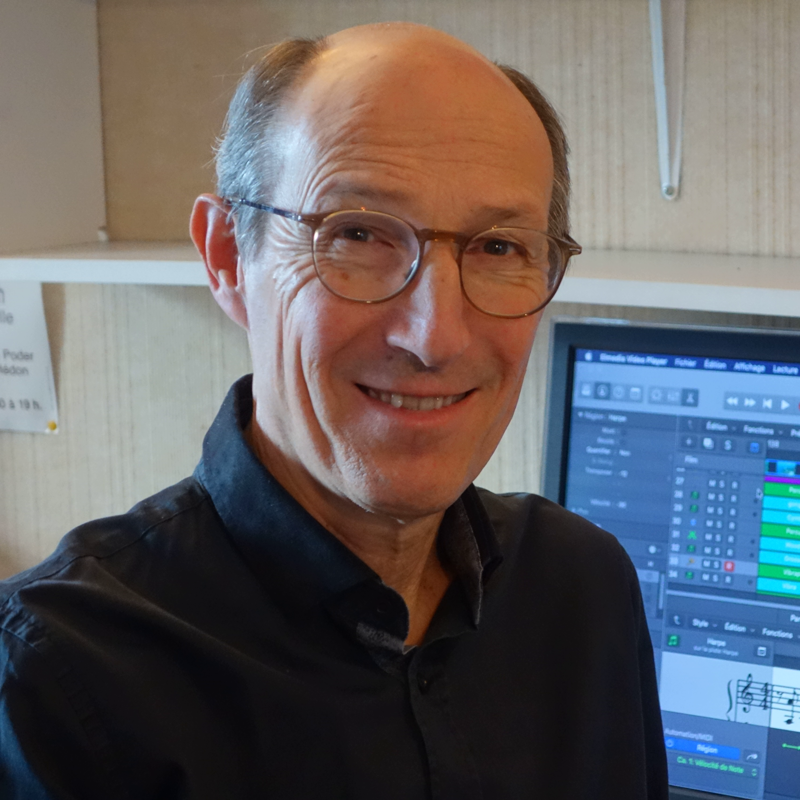

Philippe MABBOUX
*26 June 1957
Works by Philippe MABBOUX
Biography
Born in Marseille (France) in 1957, Philippe MABBOUX is a composer, improviser pianist, arranger, choirmaster and French orchestra conductor. Losing his musical studies at the Conservatories of Aix-en-Provence and Nice (musical writing and organ) and at the University of Musicology of Aix-en-Provence, he had the chance to receive the precious teachings of great Masters such as Pierre VILLETTE, Grand Prix de Rome, for harmony and counterpoint, André BOUCOURECHLIEV for musical analysis and Jean COSTA and André SAORGIN for the organ.
In 1981, he obtained the CAPES d'Education Musicale et Chant Choral, which allowed him to teach music in college and high school. It was in Saint-Raphaël and Fréjus (Var) that he spent most of his career, teaching the piano at the same time.
From the start of his teaching career, Philippe MABBOUX put his passion for musical writing at the service of his students. This is how the collection of pieces for recorder with orchestral accompaniment was born, which was published in 1987 by Jean-Marie FUZEAU (Collection IMPULSIONS ) and distributed in Europe and Canada.
In 1989, on the occasion of the Bicentenary of the French Revolution, François LEOTARD, then Minister of Culture and Mayor of Fréjus (VAR) commissioned Philippe MABBOUX to create a musical fresco for choir and orchestra which recounts the Revolution: "AU NOM DE LA LIBERTE…” This work will soon be published by Universal Edition.
In 1990, “ILIA…” a 14-minute concert piece for harp (or piano) was awarded at the DINAN International Celtic Harp Competition. A shortened version was published the same year by HARPOSPHERE (Paris) and recorded by harpist Claire LE FUR.
In 1992, he created an inter-establishment school orchestra, the Ensemble IMPULSIONS, for which he orchestrated more than 200 pieces in all styles, from classical to jazz, from pop music to film music. It will be for him a real laboratory of writing and musical experiences. With this orchestra, he will give hundreds of concerts in France, Germany, the Czech Republic, Ukraine and Holland... This orchestra, a musical educational experience unique in France at the time, will continue for more than 20 years, until 2016.
In 1999, Philippe MABBOUX received the commission for a work for the final of the International Trumpet Competition of Toulon in May 2000. This work, "TRIPTYQUE, for trumpet and organ" is published by BIM (Switzerland). It was recorded on CD by 3 trumpeters from three different countries and was used to illustrate a doctoral thesis on the musical language for the trumpet in the 20th century at Chopin University in Warsaw.
In 2000, Philippe Mabboux conducted the creation of “Il y a 2000 ans, Jesus de Nazareth…”, a large musical fresco on the life of Jesus for choir, orchestra, soloists and narrator in Saint-Raphaël.
Alongside his teaching activities, Philippe MABBOUX compose many pieces for his instrument, his confidant, the piano. Often worked on by his piano students, these pieces are regularly played in concert by the composer.
He also composes several pieces of chamber music currently being published by UE.
In 2022, Philippe Mabboux represents France at the WORLDVISION COMPOSERS CONTEST, an international composition competition, with his work "EVASIONS OCEANES", for symphony orchestra and harp, published by UE.
For 10 years, Philippe Mabboux was Chargé de Mission of the Rector of the Academy of Nice with the Orchester Régional de Cannes. In this context, pooling his experience as a composer and teacher, he organizes and presents educational concerts with the orchestra which will be attended by thousands of middle and high school students from all over the Academy.
Promoted to Professor « Agrégé » of Music Education in 2012, Philippe Mabboux is also a Knight in the Order of « Palmes Académiques ».
About the music
My musical style is the result of mixing my classical musical studies (conservatory, university) with my passion for jazz, pop music, electronic and electroacoustic music. In my symphonic works, we often find melodic and rhythmic turns from sequential repetitive music. In general, I proceed by superimposing identifiable and often quite simple melodic and rhythmic elements to create a complex sound texture. I have a taste for beautiful chords, beautiful sounds and never seek to shock or disturb the listener. The musicians who play my pieces often tell me that despite appearances, they are difficult to play and that my musical style is recognizable. I am always looking for auditory pleasure: I am my first listener and am very demanding with myself. Improvisation, an activity that I practice regularly, is very often the starting point for a new work.
